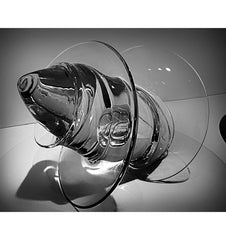
Lamps made of ancient Italian Murano glass have recently become more popular around the world. Murano glass lamps go through several processes before being finished into final products. Let's see how they are made.
Step 1 – Melting Sand
The initial step is using a furnace to melt the sand. This requires extremely high temperatures, between 1200 and 1400 degrees Celsius, and a refractive urn inside a furnace. Factory owners and managers choose the mineral mix.
These molten minerals take the shape of a glassy liquid. Colourants are typically added to the liquid glass while it is thoroughly swirled. However, this liquid is too thin to solidify into any shape. That can only be accomplished by cooling it to temperatures below 800 degrees Celsius. This is the magic temperature where the glass becomes fluid and elastic enough to be formed into a structure.
Step 2 - Evare
The subsequent process is called "levare." Workers then dip the rolling pipe (canna da soffio) in and out of the liquid and remove a measured amount for their superiors to blow. When too much glass is on the pipe, they give it a quick roll and scrape off the excess until a bubble-like glassy liquid appears. At this point, more cosmetic things, such as Murrine, are poured into the bubble, ensuring that blown objects can be decorated with ornamental materials.
Step 3 - Pontello
Glass is blown by masters, who mould the molten material into unique forms. The term "pontello" describes the procedure of shaping the finished products. The helpers are there to facilitate this procedure. They connect a rod, called a "pontil," to the bottom of the object using molten glass so the master can hold it comfortably as he gives it its final form.
Once the glass has been cooled, it must be reheated multiple times before it can be shaped. The skill of the craftsmen and the kind of object being moulded determine how many times the glass will be warmed. If you have a master craftsman, you can manufacture something in just one firing.
It takes various tools used by the masters to accomplish the shaping. Expert craftspeople use pear wood to construct a selection of the available tools. Metal is used for other instruments like shears, tongs, and pliers. Expert craftspeople, such as Roberto Donà, also create these metal items.
Step 4 - Tempera
After the master has finished his work, he places the finished product in a second furnace to cool very slowly in a muffle kiln. This prevents the item from cracking as it hardens. The concept called "tempera" describes this procedure. The final step in the cooling process is to keep it on a layer of sand.
Step 5 - Grinding
The final step in the process is performed on lamps that have been brought down to room temperature. When the items have been cooled to room temperature, the project's final step can be completed. Grinding is used to achieve the desired forms and markings for each form.
Equipment for this task includes several stone wheels of varying diameters. Unwanted bumps and inconsistencies can also be smoothed down with this method. Polishing enhances the object's overall quality. This technique, used on chilled glass, is known as moleria.

If you or someone you know wants to buy Murano Glass lamps online, MuranoNet is their best bet! We have been providing authentic, high-quality Murano Glass lamps for a long time, so we're the best place to buy Murano Glass online. Whether you want to buy Murano Glass lamps for your side table or ceiling, we have it all. Contact us today to learn more about it.



